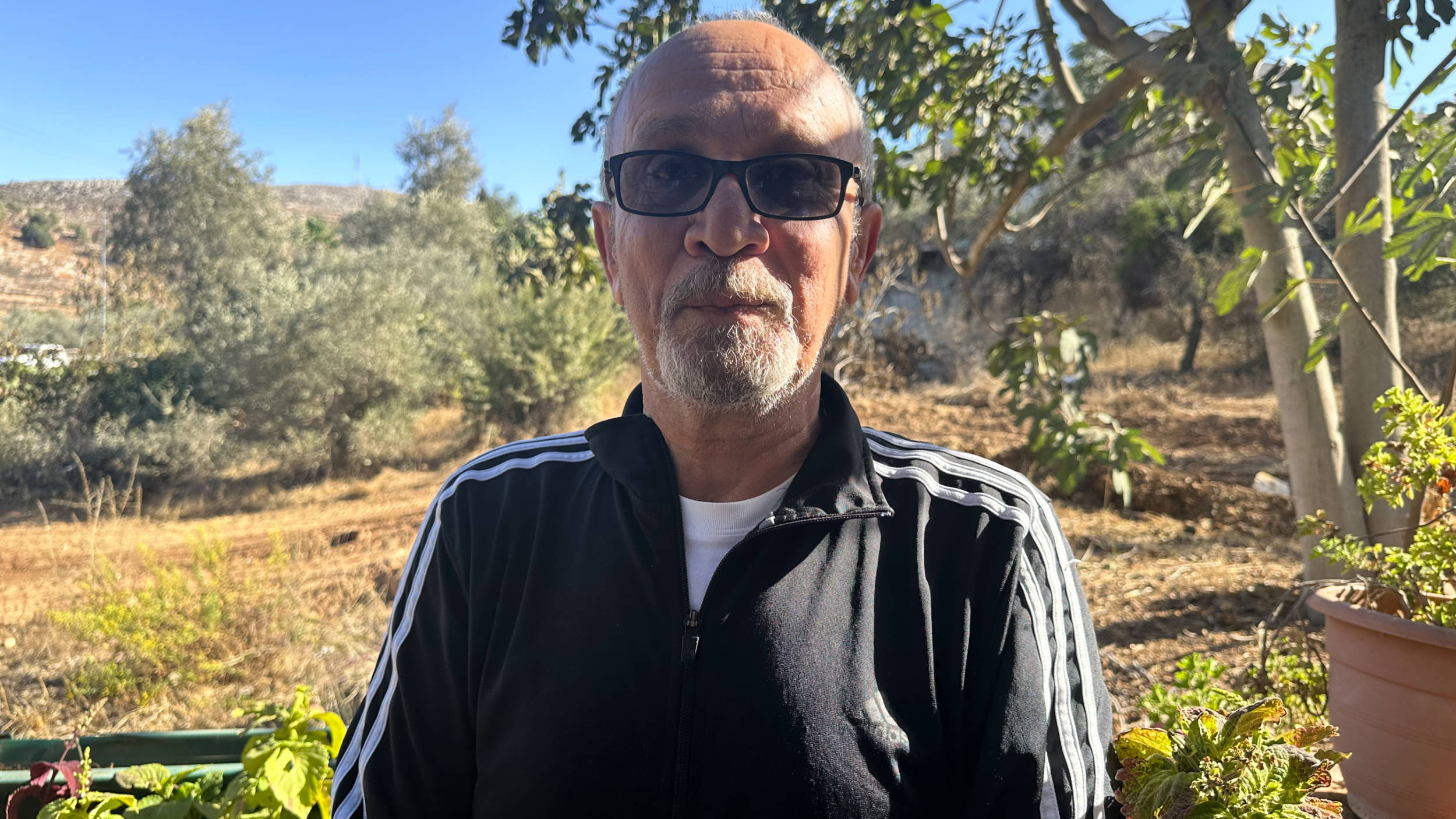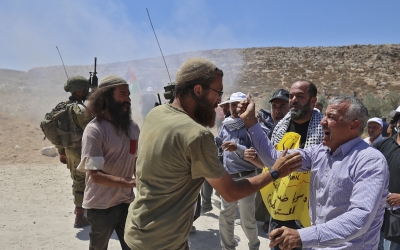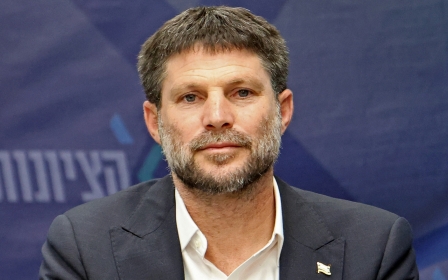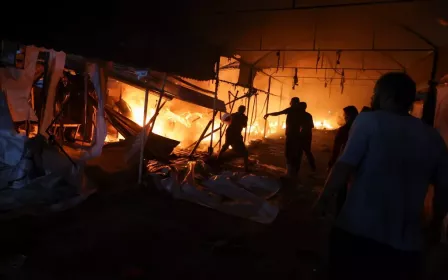Israel's new tactic to seizing West Bank lands: Settlement 'buffer zones'

Ziyad Mashhour al-Ghafari stood in the yard of his home in the Palestinian village of Sinjil, in the occupied West Bank, looking on at the olive grove his father planted decades ago and that was now destroyed.
Eight months ago, Ghafari was informed that Israeli authorities are planning to build a section of the wall that would separate his village, Sinjil, north of Ramallah, from the main road. He was not given any details regarding the design of the wall, its path, or its proximity to his house, which is closest to the road.
At the end of September, Ghafari, like other villagers, was surprised by a big number of Israeli forces, accompanied by military bulldozers, at the village’s main entrance. They then proceeded to uproot olive trees and bulldoze the area around his home. Every time he tried to approach them to ask what was happening, he was threatened at gunpoint and ordered to return to his house.
"Suddenly, our lives turned into a nightmare. The house is no longer safe; there’s no privacy, no freedom of movement, and we don’t know when or how this nightmare will end," Ghafari told Middle East Eye.
Ghafari, 62, returned years ago from the United States after a 40-year absence to rebuild his life in his hometown.
New MEE newsletter: Jerusalem Dispatch
Sign up to get the latest insights and analysis on Israel-Palestine, alongside Turkey Unpacked and other MEE newsletters
He renovated and restored his family home and started caring for the olive trees around the house.
"All my childhood before I emigrated was here. My grandfather planted these olive trees in front of me, and I played under them with my neighbours' children when I was a kid. But these bulldozers destroyed them all within hours, right before my eyes," he said.
Citing stone throwing by local youths, the Israeli Civil Administration informed the village residents several months ago of its intention to confiscate 30 dunams of the village’s land to build a 1,000-metre-long separation fence "to protect the security of settlers passing through Route 60".
Route 60 is the main road connecting northern, central and southern West Bank.
At that time, Ghafari and all the villagers tried to object to the decision, but their objections were dismissed under the claim that it was a military order that couldn’t be challenged. Three months ago, the Israeli authorities issued a second decision to add another 500-metre section to the wall.
The villagers, who do not know any additional details about the Israeli plan for their village, live in real fear of it being isolated from its surroundings.
According to their estimates, based on the work of the bulldozers, nine houses are in the path of the wall. Additionally, 49 other homes will be cut off from the village, and 8,000 dunams of agricultural land located in the northeastern area of the village will be isolated and taken over, to be annexed into four other existing settlements in the area.
"The settlers have been trying for years to take control of this area, and the residents have managed to repel them," Moez Twafsha, the mayor of Sinjil, told MEE. "But now they are exploiting the war and using flimsy excuses like preventing stone-throwing."
Since the war on Gaza began a year ago, landowners have been prohibited from accessing their lands, and Israeli forces have closed the village's main road. Anyone who tries to approach is attacked.
According to Twafsha, this decision not only affects the village but also impacts the freedom of movement on Route 60.
Wholesale separation
Looking at the pattern of other similar decisions, Israel aims, through building buffer zones around several villages like Sinjil in the West Bank, to completely separate these communities from their Palestinian surroundings and prevent their connection to the wider region.
'Suddenly, our lives turned into a nightmare. The house is no longer safe; there’s no privacy, no freedom of movement'
- Ziyad al-Ghafari, villager
According to the Colonization and Wall Resistance Commission, a Palestinian governmental body, Israel issued 13 military orders after 7 October 2023 to establish buffer zones for building sections of the wall or fences around settlements in strategic areas of the West Bank.
These areas are spread across different locations. In Ramallah Governorate: Al-Mazra'a al-Gharbiya around the Harash outpost, and Deir Dibwan around the Mitzpe Dani settlement.
In Salfit Governorate: Yasuf around the Kfar Tapuach settlement, Iskaka around the Neve Nehemia settlement, Qarawat Bani Hassan and Haris towns around the Karnei Shomron settlement, and Deir Istiya around the Revava settlement.
In Nablus Governorate: Burqa around the Homesh settlement. A second area near Awarta and Rujeib around the Itamar settlement, and a third area in As-Sawiya and Yatma around the Rehalim settlement. In addition to a fourth area in the villages of Burin, Madama, and Asira al-Qibliya around the Yitzhar settlement.
In Qalqilya: near Kafr Qaddum, a buffer zone is planned around the Kedumim settlement.
In Bethlehem: Nahalin and Al-Jaba’a villages around the Gvaot settlement.
Around Jerusalem: in the Jaba village, a buffer zone is planned around the Geva Binyamin settlement.
While the details of the wall plans for Sinjil are unclear, some villages have not yet received official decisions on the construction, despite the orders being issued months ago, as is the case with Burqa, north of Nablus.
The return of settlers
This wall will isolate areas near the Homesh settlement, to which settlers have returned after they were evacuated following the Israeli Disengagement Plan, under which Israel evacuated settlements in Gaza and some in the West Bank in 2005.
Years later, in 2013, the villagers received a decision from the Israeli Supreme Court that granted them the right to regain about 1,200 dunams of their agricultural lands that occupation forces had seized in 1978 to build the settlement.
The villagers began rehabilitating their lands and preparing to build on them, only to now face a new battle against settlement expansion.
However, the major blow came in March 2023, when the Israeli government approved a bill to "repeal the Disengagement Law" in the West Bank, allowing settlers to return to four dismantled settlements, including Homesh.
Settlers in Homesh have since repeatedly attacked the villagers and their agricultural lands.
Ziyad Abu Omar, the head of the village council in Burqa, said that the issue extends beyond the previously confiscated lands, as settlers are now expanding into more than 500 new dunams of the village’s land.
"We haven't yet received a decision to confiscate lands for building the wall, but we see Israeli bulldozers working daily in the area, clearing land and putting up more fences around the caravans that were recently installed," he told MEE.
Annexation and separation plans
These enclaves, despite the danger they pose to the Palestinian communities being isolated in the West Bank, are only part of the larger plan that will turn the West Bank into a bleak reality, according to Jamal Juma, the coordinator of the Palestinian Popular Campaign Against the Apartheid Wall.
These decisions are part of the annexation plan for the West Bank, which is being rapidly implemented by exploiting the war conditions in Gaza.
"What is happening on the ground is that these military orders for land confiscation here and there are misleading. While the military order might talk about confiscating 10 dunams from a Palestinian village, in practice, it isolates and confiscates thousands of dunams around it," Juma said.
"This land is eventually annexed to existing settlements, expanding them or creating connections between them."
In the case of the village of Sinjil, the decision mentions 1,500 metres of the wall and the confiscation of 30 dunams to build it. However, in reality, this wall will isolate 8,000 dunams and annex them to the Ma'ale Levona settlement, linking it with the Shilo and Eli settlements and new outposts, creating a massive settlement bloc in the area. This could potentially lead to the complete closure of the road for Palestinians and its control by settlers.
All these measures, along with other plans to build more settlements and expand smaller ones, are tipping the balance in the West Bank, turning Palestinian communities into a minority confined to isolated enclaves, with the keys to these enclaves in the hands of the Israeli occupation.
In 1995, the Oslo Agreement divided the West Bank into three zones. Areas A and B are under the civil administration of the Palestinian Authority, while Area C, which comprises around 60 percent of the West Bank, remains under full Israeli military and civil control.
"Now, we are talking about a complete separation system that doesn't just involve the annexation of Area C but also the classified Areas A and B, surrounding these villages entirely and controlling the movement of their residents," Juma said.
Middle East Eye delivers independent and unrivalled coverage and analysis of the Middle East, North Africa and beyond. To learn more about republishing this content and the associated fees, please fill out this form. More about MEE can be found here.







